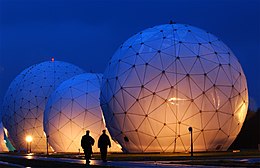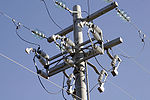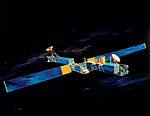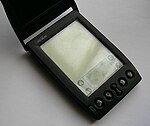| Revision as of 05:56, 26 November 2005 editCedars (talk | contribs)Extended confirmed users5,141 editsm line break← Previous edit | Revision as of 10:11, 26 November 2005 edit undoCedars (talk | contribs)Extended confirmed users5,141 editsm move systematic bias tag to talk pageNext edit → | ||
| Line 1: | Line 1: | ||
| {{globalize}} | |||
| {{dispute}} | {{dispute}} | ||
Revision as of 10:11, 26 November 2005
| This article's factual accuracy is disputed. Relevant discussion may be found on the talk page. Please help to ensure that disputed statements are reliably sourced. (Learn how and when to remove this message) |
Electrical engineering is an engineering discipline that deals with the study and application of electricity and electromagnetism. Its practitioners are called electrical engineers. Electrical engineering is a broad field that encompasses many subfields including those that deal with power, control systems, electronics and telecommunications.
Electrical engineering is sometimes distinguished from electronics engineering. Where this distinction is made, electrical engineering is considered to deal with the problems associated with large scale electrical systems such as power transmission and motor control where as electronics engineering is considered to deal with the problems associated with small scale electronic systems such as printed circuit board design and very-large-scale integration. However electronics engineering can also be viewed as a subfield of electrical engineering and this is how electronics engineering is treated in this article.
History
Early developments in electricity
Electricity has been a subject of scientific interest since at least the seventeenth century. However it was not until the nineteenth century that research into the subject started to intensify. Notable developments in this century include the work of Georg Ohm who in 1827 quantified the relationship between the electric current and potential difference in a conductor and the work of Michael Faraday who in 1831 discovered electromagnetic induction.
However during these years the study of electricity was largely considered to be a subfield of physics and hence the domain of physicists. It was not until the late nineteenth century that universities started to offer degrees in electrical engineering. The Darmstadt University of Technology established the first chair of electrical engineering worldwide in 1882 and offered a four year study course of electrical engineering in 1883. In 1882, MIT offered the first course on electrical engineering in the United States. This course was organized by Professor Charles Cross who was head of the Physics department and who later became a founder of the American Institute of Electrical Engineers (which later became the Institute of Electrical and Electronics Engineers). In 1885, the University College London founded the first chair of electrical engineering in the United Kingdom and, in 1886, the University of Missouri established the first department of electrical engineering in the United States.
During this period, work in the area increased dramatically. In 1882, Edison switched on the world's first large-scale electrical supply network that provided 110 volts direct current to fifty-nine customers in lower Manhattan. In 1887, Nikola Tesla filed a number of patents related to a competing form of power distribution known as alternating current. In the following years a bitter rivalry between Tesla and Edison, known as the "War of Currents", took place over the preferred method of distribution.
Tesla's work on induction motors and polyphase systems influenced electrical engineering for years to come. Edison's work on telegraphy and his development of the stock ticker proved lucrative for his company (which eventually became one of the world's largest companies, General Electric). As well as the contributions of Edison and Tesla, a number of other figures played an equally important role in the progress of electrical engineering at this time.
The emergence of radio and electronics
In 1896, Guglielmo Marconi made the world's first wireless radio transmission. In 1905, John Fleming invented the first radio tube, the diode. One year later, in 1906, Robert von Lieben and Lee De Forest independently developed the amplifier tube, called the triode.
In 1926, John Logie Baird built the first mechanical television using simple techniques and based on the Nipkow disk. The first colour television followed in 1928. In the same year, the first successful transatlantic television transmission was made from London to New York. However, Baird's invention became outdated in 1931 when Manfred von Ardenne introduced the cathode ray tube and thus the electronic television.
In 1942, Konrad Zuse presented the Z3, the world's first functional computer. In 1946, the ENIAC (Electronic Numerical Integrator and Computer) of John Presper Eckert and John Mauchly followed, beginning the computing era. The arithmetic performance of these machines allowed engineers to develop completely new technologies and achieve new objectives. Early examples include the Apollo missions and the NASA moon landing.
The invention of the transistor in 1947 by William B. Shockley, John Bardeen and Walter Brattain opened the door for more compact devices and led to the development of the integrated circuit in 1959 by Jack Kilby and independently in 1961 by Robert Noyce. In 1958, G.C. Devol and J. Engelberger invented and built in the USA the world's first industrial robot. Such a robot was used for the first time in 1960 in industrial production by General Motors.
In 1968, Marcian Hoff at Intel invented the microprocessor and thus ignited the development of the personal computer. Hoff's invention was part of an order by a Japanese company for a desktop computer, which Hoff wanted to build as cheaply as possible. The first realization of the microprocessor was the Intel 4004, a 4-bit processor, in 1969, but only in 1973 did the Intel 8080, an 8-bit processor, make the building of the first personal computer, the Altair 8800, possible.
Training and certification
Electrical engineers typically possess an academic degree with a major in electrical engineering. The length of study for such a degree is usually three or four years and the completed degree may be designated as a Bachelor of Engineering, Bachelor of Science or Bachelor of Applied Science depending upon the university.
The degree generally includes units covering physics, mathematics, project management and specific topics in electrical and electronics engineering. Initially such topics cover most, if not all, of the subfields of electrical engineering. Students then choose to specialize in one or more subfields towards the end of the degree.
Some electrical engineers also choose to pursue a postgraduate degree such as a Master of Engineering, a Doctor of Philosophy in Engineering or an Engineer's degree. The Master and Engineer's degree may consist of either research, coursework or a mixture of the two. The Doctor of Philosophy consists of a significant research component and is often viewed as the entry point to academia. In the United Kingdom and various other European countries, the Master of Engineering is often considered an undergraduate degree of slightly longer duration than the Bachelor of Engineering.
In most countries, a Bachelor's degree in engineering represents the first step towards certification and the degree program itself is certified by a professional body. After completing a certified degree program the engineer must satisfy a range of requirements (including work experience requirements) before being certified. Once certified the engineer is designated the title of Professional Engineer (in the United States and Canada), Chartered Engineer (in the United Kingdom, Ireland, India, South Africa and Zimbabwe), Chartered Professional Engineer (in Australia) or European Engineer (in much of the European Union).
The advantages of certification vary depending upon location. For example, in the United States and Canada "only a licensed engineer may...seal engineering work for public and private clients". This requirement is enforced by state and provincial legislation such as Quebec's Engineers Act. In other countries, such as Australia, no such legislation exists. Practically all certifying bodies maintain a code of ethics that they expect all members to abide by or risk expulsion. In this way these organizations play an important role in maintaining ethical standards for the profession. Even in jurisdictions where certification has little or no legal bearing on work, engineers are subject to contract law. In cases where an engineer's work fails he or she may be subject to the tort of negligence and, in extreme cases, the charge of criminal negligence. An engineer's work must also comply with numerous other rules and regulations such as building codes and legislation pertaining to environmental law.
Significant professional bodies for electrical engineers include the Institute of Electrical and Electronics Engineers (IEEE) and the Institution of Electrical Engineers (IEE). The IEEE claims to produce 30 percent of the world's literature on electrical engineering, has over 360,000 members worldwide and holds over 300 conferences anually. The IEE publishes 14 journals, has a worldwide membership of 120,000, certifies Chartered Engineers in the United Kingdom and claims to be the largest professional engineering society in Europe.
Tools and work
From the global positioning system to electric power generation, electrical engineers are responsible for a wide range of technologies. They design, develop, test and supervise the deployment of electrical systems and electronic devices. For example, they may work on the design of telecommunication systems, the operation of electric power stations, the lighting and wiring of buildings, the design of household appliances or the electrical control of industrial machinery.

Fundamental to the discipline are the sciences of physics and mathematics as these help to obtain both a qualitative and quantitative description of how such systems will work. Today most engineering work involves the use of computers and it is commonplace to use computer-aided design programs when designing electrical systems. Nevertheless, the ability to sketch ideas is still invaluable for quickly communicating with others.
Although most electrical engineers will understand basic circuit theory, the theories employed by engineers generally depend upon the work they do. For example, quantum mechanics and solid state physics might be relevant to an engineer working on VLSI but are largely irrelevant to engineers working with macroscopic electrical systems. Even circuit theory may not be relevant to a person designing telecommunication systems that use off-the-shelf components. Perhaps the most important technical skills for electrical engineers are reflected in university programs, which emphasize strong numerical skills, computer literacy and the ability to understand the technical language and concepts that relate to electrical engineering.
For most engineers technical work accounts for only a fraction of the work they do. A lot of time is also spent on tasks such as discussing proposals with clients, preparing budgets and determining project schedules. Many senior engineers manage a team of technicians or other engineers and for this reason project management skills are important. Most engineering projects involve some form of documentation and strong written communication skills are therefore very important.
The workplaces of electrical engineers are just as varied as the types of work they do. Electrical engineers may be found in the pristine lab environment of a fabrication plant, the offices of a consulting firm or on site at a mine. During their working life, electrical engineers may find themselves supervising a wide range of individuals including scientists, electricians, computer programmers and other engineers.
Obsolescence of technical skills is a serious concern for electrical engineers. Membership and participation in technical societies, regular reviews of periodicals in the field and a habit of continued learning are therefore essential to maintaining proficiency.
Demographics

There are around 366,000 people working as electrical engineers in the United States constituting 0.25% of the labour force (2002). This makes electrical engineering the largest engineering discipline in the United States with the exception of software engineering. In Australia, there are around 24,000 constituting 0.23% of the labour force (2005) and in Canada, there are around 34,600 constituting 0.21% of the labour force (2001). All of these countries expect employment in the field to grow, but not rapidly, in the near future.
Outside of these countries, it is difficult to gauge the demographics of the profession due to less meticulous reporting on labour statistics. One way to estimate the relative size of the profession in each country is to compare graduation statistics. In 2002, the National Science Foundation published statistics on the number of degrees granted in engineering by various countries. A summary of these statistics is shown on the right though the foundation notes that the numbers "may not be strictly comparable".
In the United States and, to a lesser extent, throughout the western world there is a perception that a large number of technical jobs including those concerned with electrical engineering are being outsourced to countries such as India and China. To illustrate this claim statistics are often misrepresented (see note). Overall probably one of the best summaries of the effect of outsourcing on the United States is given by the U.S. Department of Labor which notes that "increasing use of engineering services performed in other countries will act to limit employment growth" but that overall the profession "is expected to grow more slowly than the average for all occupations through 2012".
Other statements on the profession are less controversial. In the United States, the number of electrical engineers graduating has fallen from a peak in the mid-1980's. In 2000, engineering degrees formed less than 20% of the degrees granted in the United States and Australia, compared to just over 25% for the United Kingdom and Japan and over 30% for Germany and South Korea. Also widely accepted is that the profession is male dominated. This is illustrated by the statistical sources in the first paragraph that show 96% of electrical engineers in Australia and 89% of electrical engineers in Canada are male.
Subfields
Electrical engineering has many subfields. This section describes seven of the most popular subfields in electrical engineering. Although there are engineers who focus exclusively on one subfield, there are also many who focus on a combination of subfields. For more information on each of the following, read the subfields of electrical engineering article.

|
Power engineering deals with the generation, transmission and distribution of electricity as well as the design of a range of related devices. These include transformers, electric generators, electric motors and sometimes power electronics.
In many regions of the world, governments maintain an electrical network that connects a variety of generators together with users of their energy. This network is called a power grid. Users purchase electrical energy from the grid avoiding the costly exercise of having to generate their own. Power engineers may work on the design and maintenance of the power grid as well as the power systems that connect to it. Such systems are called on-grid power systems and may supply the grid with additional power, draw power from the grid or do both. Power engineers may also work on systems that do not connect to the grid. These systems are called off-grid power systems and may be used in preference to on-grid systems for a variety of reasons. Read more...
|

|
Control engineering focuses on the modelling of a diverse range of dynamic systems and the design of controllers that will cause these systems to behave in the desired manner. To implement such controllers electrical engineers may use electrical circuits, digital signal processors and microcontrollers.
Control engineering has a wide range of applications from the flight and propulsion systems of commercial airliners to the cruise control present in many modern automobiles. It also plays an important role in industrial automation. Control engineers often utilize feedback when designing control systems. For example, in an automobile with cruise control the vehicle's speed is continuously monitored and fed back to the system which adjusts the motor's speed accordingly. Where there is regular feedback, control theory can be used to determine how the system responds to such feedback. Read more...
|

|
Electronics engineering involves the design and testing of electronic circuits that use the properties of components such as resistors, capacitors, inductors, diodes and transistors to achieve a particular functionality. The tuner circuit, which allows the user of a radio to filter out all but a single station, is just one example of such a circuit.
Before the invention of the integrated circuit in 1959, electronic circuits were constructed from discrete components that could be manipulated by humans. These non-integrated circuits consumed much space and power, were limited in speed although they are still common in some applications. By contrast, integrated circuits packed a large number - often millions - of tiny electrical components, mainly transistors, into a small chip around the size of a coin. This allowed for the powerful computers and other electronic devices we see today. Read more...
|
| File:IPod 4G.jpg | Signal processing deals with the analysis and manipulation of signals. Signals can be either analog, in which case the signal varies continuously according to the information, or digital, in which case the signal varies according to a series of discrete values representing the information.
For analog signals, signal processing may involve the amplification and filtering of audio signals for audio equipment or the modulation and demodulation of signals for telecommunications. For digital signals, signal processing may involve the compression, error checking and error detection of digital signals. Read more...
|

|
Telecommunications engineering focuses on the transmission of information across a channel such as a coax cable, optical fibre or free space.
Transmissions across free space require information to be encoded in a carrier wave in order to shift the information to a carrier frequency suitable for transmission, this is known as modulation. Popular analog modulation techniques include amplitude modulation and frequency modulation. The choice of modulation affects the cost and performance of a system and these two factors must be balanced carefully by the engineer. Once the transmission characteristics of a system are determined, telecommunication engineers design the transmitters and receivers needed for such systems. These two are sometimes combined to form a two-way communication device known as a transceiver. A key consideration in the design of transmitters is their power consumption as this is closely related to their signal strength. If the signal strength of a transmitter is insufficient the signal's information will be corrupted by noise. Read more...
|

|
Instrumentation engineering deals with the design of devices to measure physical quantities such as pressure, flow and temperature. These devices are known as instrumentation.
The design of such instrumentation requires a good understanding of physics that often extends beyond electromagnetic theory. For example, radar guns use the Doppler effect to measure the speed of oncoming vehicles. Similarly, thermocouples use the Peltier-Seebeck effect to measure the temperature difference between two points. Often instrumentation is not used by itself, but instead as the sensors of larger electrical systems. For example, a thermocouple might be used to help ensure a furnace's temperature remains constant. For this reason, instrumentation engineering is often viewed as the counterpart of control engineering. Read more...
|

|
Computer engineering deals with the design of computers and computer systems. This may involve the design of new hardware, the design of PDAs or the use of computers to control an industrial plant. Computer engineers may also work on a system's software. However, the design of complex software systems is often the domain of software engineering, which is usually considered a separate discipline.
Desktop computers represent a tiny fraction of the devices a computer engineer might work on, as computer-like architectures are now found in a range of devices including video game consoles and DVD players. Read more...
|
Related disciplines
One discipline related to electrical engineering is that of mechatronics. Mechatronics is an engineering discipline, which deals with the convergence of electrical and mechanical systems. Such combined systems are known as electromechanical systems and have widespread adoption. Examples include automated manufacturing systems, heating, ventilation and air-conditioning systems and various subsystems of aircrafts and automobiles.
The term mechatronics is typically used to refer to macroscopic systems but futurists have predicted the emergence of very small electromechanical devices. Already such small devices, known as micro electromechanical systems (MEMS), are used in automobiles to tell airbags when to deploy, in digital projectors to create sharper images and in inkjet printers to create nozzles for high-definition printing. In the future it is hoped the devices will help build tiny implantable medical devices and improve optical communication.
Another related discipline is that of biomedical engineering, which is concerned with the design of medical equipment. This includes fixed equipment such as ventilators, MRI scanners and electrocardiograph monitors as well as mobile equipment such as cochlear implants, artificial pacemakers and artificial hearts.
References
Notes
- Note I - In October 2002, Cadence Design Systems CEO Ray Bingham announced that "China produces 600,000 engineers a year, and 200,000 are electrical engineers." The United States branch of the IEEE disputed this pointing out that it was triple the figure reported for 1999 by the National Science Foundation. Other sources draw comparisons using the number of engineering graduates reported by the All India Council for Technical Education (350,000) with that reported by the National Science Foundation (60,000) . But this comparison is dubious because the National Science Foundation excludes software engineers from its statstics. A more reasonable comparison is probably given by U.S. News who suggest the Indian figure is around 82,000.
Citations
- . ISBN 087942172X.
{{cite book}}: Missing or empty|title=(help); Unknown parameter|Author=ignored (|author=suggested) (help); Unknown parameter|Publisher=ignored (|publisher=suggested) (help); Unknown parameter|Title=ignored (|title=suggested) (help); Unknown parameter|Year=ignored (|year=suggested) (help)CS1 maint: extra punctuation (link) - "Why Should You Get Licensed?". National Society of Professional Engineers. July 11.
{{cite web}}: Check date values in:|date=and|year=/|date=mismatch (help) - "Engineers Act". Quebec Statutes and Regulations (CanLII). July 24.
{{cite web}}: Check date values in:|date=and|year=/|date=mismatch (help) - Shuman, Ellis (May 27, 2001). "Joy turns to tragedy in collapse of Versailles wedding hall".
{{cite news}}: Unknown parameter|org=ignored (help) - "Codes of Ethics and Conduct". Online Ethics Center. July 24.
{{cite web}}: Check date values in:|date=and|year=/|date=mismatch (help) - "About the IEEE". IEEE. July 11.
{{cite web}}: Check date values in:|date=and|year=/|date=mismatch (help) - "About the IEE". The IEE. July 11.
{{cite web}}: Check date values in:|date=and|year=/|date=mismatch (help) - "Journal and Magazines". The IEE. July 11.
{{cite web}}: Check date values in:|date=and|year=/|date=mismatch (help) - "Electrical and Electronics Engineers, except Computer". Occupational Outlook Handbook. July 16.
{{cite web}}: Check date values in:|date=and|year=/|date=mismatch (help) (see here regarding copyright) - Trevelyan, James; (2005). What Do Engineers Really Do?. University of Western Australia. (seminar with slides)
- "Electrical and Electronics Engineers, except Computer". Occupational Outlook Handbook. July 16.
{{cite web}}: Check date values in:|date=and|year=/|date=mismatch (help) - "Electrical and Electronics Engineers, except Computer". Occupational Outlook Handbook. August 27.
{{cite web}}: Check date values in:|date=and|year=/|date=mismatch (help) and "Computer Hardware Engineers". Occupational Outlook Handbook. August 27.{{cite web}}: Check date values in:|date=and|year=/|date=mismatch (help) - "Electrical and Electronics Engineers". Australian Careers. August 27.
{{cite web}}: Check date values in:|date=and|year=/|date=mismatch (help) - "Electrical and Electronics Engineers (NOC 2133)". Job Futures (National Edition). August 27.
{{cite web}}: Check date values in:|date=and|year=/|date=mismatch (help) - National Science Foundation (2002), Science and Engineering Indicators 2002, Appendix 2-18.
- "Electrical and Electronics Engineers, except Computer". Occupational Outlook Handbook. July 16.
{{cite web}}: Check date values in:|date=and|year=/|date=mismatch (help) - "Electrical engineering degrees awarded, by degree level and sex of recipient: 1966–2001" (PDF). Science and Engineering Degrees: 1966-2001. August 27.
{{cite web}}: Check date values in:|date=and|year=/|date=mismatch (help) - Department of Education, Science and Training (2004), Australian Australian Science and Technology at a glance 2004 - Human Resources in Science and Technology, slide 10.
- "MEMS the world!". IntelliSense Software Corporation. July 17.
{{cite web}}: Check date values in:|date=and|year=/|date=mismatch (help) - IEEE-USA, IEEE-USA Seeks to Substantiate Information in the H-1B Guest Worker Visa Policy Debate, January 30, 2003.
- Template:Citepaper version
- "Engineering degrees awarded, by degree level and sex of recipient: 1966–2001" (PDF). Science and Engineering Degrees: 1966-2001. August 27.
{{cite web}}: Check date values in:|date=and|year=/|date=mismatch (help) - Atlas, Terry (February 5, 2005). "Bangalore's Big Dreams".
{{cite news}}: Unknown parameter|org=ignored (help)
See also
- List of electrical engineering topics (alphabetical)
- List of electrical engineering topics (thematic)
- List of electrical engineers
- Subfields of electrical engineering
- Electronic design automation
- Computer engineering
- IEEE Nikola Tesla Award
External links
- History of the IEEE Electrical Engineering Professional Society at its website
- All About Circuits Learn the nuts and bolts about building electrical circuits, and to build appliances based on electrical circuits
- IEEE Virtual Museum A virtual museum that illustrates many of the basic electrical engineering and electricity concepts through examples, figures, and interviews.
- Sloan Career Center: Electrical Engineering This is an excellent resource for anyone that is interested in electrical engineering as a career. Learn what electrical engineers do on a daily basis, where they work, how much they earn, and much more.
| Technology and related concepts | |||||||||||||||||||||||||||||||||
|---|---|---|---|---|---|---|---|---|---|---|---|---|---|---|---|---|---|---|---|---|---|---|---|---|---|---|---|---|---|---|---|---|---|
| |||||||||||||||||||||||||||||||||
| |||||||||||||||||||||||||||||||||
| |||||||||||||||||||||||||||||||||